(Yellow
lab, Yellow Labido, Electric Yellow, Labidochromis Nkali, Labidochromis
white, Golden.)
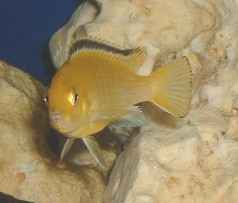
Female
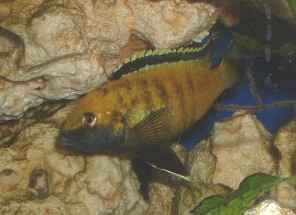
Dominant
Male
This
is one of the most commonly kept African Cichlids and is THE most common
Malawi Cichlid to be kept in home aquariums. It is a Rock dwelling Mbuna
and is a maternal mouthbrooder. The reasons for its popularity are primarily
its looks, size and temperament but, fairly obvious sexing, and ease
of breeding contribute to keep this in the Top Ten of African Cichlids!
Appearance:
The most popular and widespread form of Labidochromis Caeruleus is a
Bright Yellow - hence its common names (Both Males and Females are Yellow
with the Males having black pigment in their finnage). In fact it exists
in Blue and White and in the wild the Yellow version is only to be found
in the Northeast part of the lake between Charo and Lions Cove.
Size:
Yellow Labs are a dwarf species and can reach a length of 10-13 cm (4-5
in.). The females are commonly smaller than the male (2-3 in).
Temperament:
Lab. Caeruleus is a quiet and peaceful Mbuna, and is a perfect cichlid
for Aquarists moving from Community fishkeeping to the colourful world
of Cichlids. However, be warned, a quiet and peaceful Cichlid is still
a Cichlid, Yellow labs are not suitable for adding to your community
tank and doing so may well result in not only, rather fewer fish than
you start with but also unhappy fish all around.
Sexing:
Adult dominant males are extremely easy to sex - They have Black Anal
and Ventral Fins and a Black Dorsal Fin with a bright yellow top stripe,
as they age they also develop more Black pigment leading to a jet black
underside and Charcoal Stripes on its body, from the front they look
as though they are wearing a Mask . 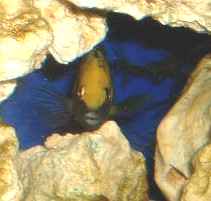 Sub
dominant males are harder to sex in that whilst they will usually also
have black Anal/Ventral fins the black pigment is far less pronounced
leading to easy confusion between sub dominant Males and Females.
Sub
dominant males are harder to sex in that whilst they will usually also
have black Anal/Ventral fins the black pigment is far less pronounced
leading to easy confusion between sub dominant Males and Females.
Female Yellow Labs are a paler/pastel version of the Males - They tend
not to have any black Anal/Ventral fins these instead being a pale yellow,
The Females tend to be much smaller than the Males although this difference
is not obvious as Juveniles when all the Fish are the same size.
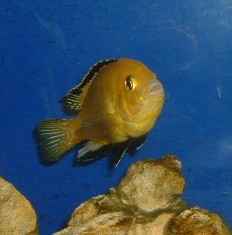
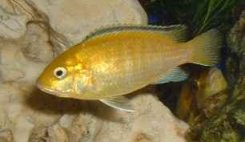
Breeding/Reproduction:
Labidochromis caeruleus is one of the easiest mouthbrooders to breed.
Either buy five or six juvenile fish (try for a ratio of at least two
females to each male) and grow them on. They will breed from around
six months of age or about 1-1/2 inches in length. Or buy Trios of Adults
in the same ratio. Breeding occurs as for many mbuna. The Male will
select a spawning site, it could be on a piece of Slate or on the bare
bottom. He will flirt with all the females until one responds and follows
him. The female deposits the eggs in the immediate area, and the male
follows fertilizing the eggs. The female returns and picks up the eggs
holding them in her buccal cavity (beneath lower Jaw/throat) and also
deposits more eggs. This can go on for about an hour. The female will
then hide out and begin to brood. (The male starts looking for the next
female - his involvement at an end).
Females are generally good "holders" and will refuse food
for up to four weeks. Because going for food for so long weakens the
female it is a good idea to remove her from the Main tank into a separate
tank anytime after you see her obviously "Holding". This means
that after she has released the Fry you can feed her up before returning
her to her often boisterous tankmates. Upon release of the Fry she will
continue to care for them for about a week given the opportunity and
providing she has plenty of food the fry should be in no danger. The
actual time she will hold depends on a number of factors and Temperature
plays a significant part with release times recorded of 25 days at 27-28°
C (81-82° F) or 40 days at 23-24° C (73-75° F) so somewhere
between these would be the average. The number of Fry is generally quite
small with Young females producing 5-8 Fry and older more experienced
fish producing up to 15.
Keeping
Labidochromis Caeruleus in the home Aquarium
pH: 7.7 - 8.6 (This is the variation found in Lake Malawi) Aim
for midpoint.
Hardness: Aim for 8-10 KH and a little higher ideally for GH
(Most aquarists think all Rift lakes are extremely hard water-This is
not necessarily so) Aim for Harder end of scale to achieve regular spawning.
Temperature: 73-82 F (23-28 C)
Minimum Aquarium size 120 Litres, Ideal size from 300 Litres upwards.
Décor: Provide Lots of Rock work/Caves and fine Gravel
or Sand as substrate. Whilst they do not dig up plants they will often
eat them so Plants happy in their environment would be those such as
Java Fern.
Filtration: Lake Malawi is a lake so vast that there is no measurable
pollution, in the wild, Malawi fish would never have to cope with Ammonia
or Nitrite OR Nitrate, therefore you should aim at keeping your water
conditions as close to perfect as possible. The only way to do this
is via Efficient Filtration and regular water changes. Undergravel filters
are not really suitable for any Mbuna due to their digging habits so
I would recommend a Good quality External or Internal Power filter or
two. Malawi fish require well oxygenated water achieved by good surface
movement and are high waste producing fish. Therefore your filter should
ideally turn tank water over at least 5 times an hour but bear in mind
that it is not necessary to have white water rapids at the surface.
Feeding:
Labidochromis Caeruleus are Mbuna and Mbuna need vegetables (herbivores)
while other Cichlids mainly feed in high protein, frozen and even live
foods (omnivores, carnivores or piscivores). Providing Yellow Labs with
too much protein may cause the Malawi bloat disease which is extremely
difficult to be treated and usually fatal. Restrict food stuffs to good
quality Flake food with a high vegetable content and pellets and alternate
these with High vegetable content frozen food, Lettuce on a clip (Labs
love Lettuce!), shelled peas and once a week or so Live brine shrimp.
Avoid Tubifex and blood worms because although they will eat it with
relish, tubifex worms should be avoided since they are reported to carry
many microorganisms which may harm your fish. Leave them without any
food at least once a week.
Author: Alyson
Bateman







